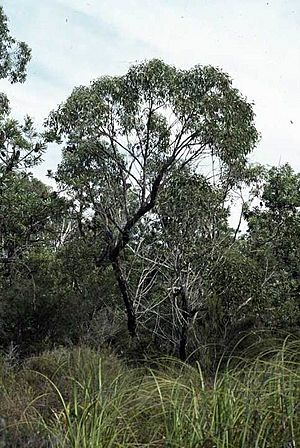Swamp stringybark facts for kids
Quick facts for kids Swamp stringybark |
|
|---|---|
 |
|
| Conservation status | |
| Scientific classification | |
| Genus: |
Eucalyptus
|
| Species: |
conglomerata
|
The swamp stringybark (Eucalyptus conglomerata) is a special type of tree or shrub. It is found only in Queensland, Australia. This plant gets its name from its rough, stringy bark. It has long, narrow leaves, white flowers, and small, barrel-shaped fruits.
Contents
What is a Swamp Stringybark?
The swamp stringybark is usually a small, straggly tree or a mallee. A mallee is a type of eucalyptus that grows many stems from a large, woody base. This woody base is called a lignotuber, which helps the plant regrow after fires.
These plants typically grow to be about 8 to 12 meters (26 to 39 feet) tall. They have greyish-brown, fibrous bark that covers the trunk and most of the branches. Sometimes, the very thinnest branches have smooth bark.
Leaves and Flowers
Young swamp stringybark plants have glossy green leaves. These leaves are narrow and can be 18 to 42 millimeters (0.7 to 1.7 inches) long. They grow on a short stalk called a petiole.
Older, adult leaves are also glossy green on both sides. They are longer, about 70 to 137 millimeters (2.8 to 5.4 inches) long. These leaves are shaped like a spear or an oval.
The flowers of the swamp stringybark are white. They grow in groups of eleven to fifteen or more. Each group sits on a small stalk called a peduncle. The individual flowers might not have a stalk (called sessile) or have a very short one.
Fruit
When the flowers are ready, they are oval-shaped buds. They are about 4 to 5 millimeters (0.16 to 0.20 inches) long. These buds have a cone-shaped cap called an operculum that falls off when the flower opens.
Swamp stringybarks usually flower between April and August. After flowering, they produce woody fruits. These fruits are shaped like small barrels and are about 2 to 5 millimeters (0.08 to 0.20 inches) long. They grow in clusters on the plant.
How it Got its Name
The swamp stringybark was first officially described in 1929. Two botanists, Joseph Maiden and William Blakely, gave it the scientific name Eucalyptus conglomerata.
The word conglomerata comes from Latin. It means "crowded" or "concentrated." This name refers to how the fruits of this eucalyptus grow close together in clusters.
Where it Lives
The swamp stringybark grows in damp, sandy soil. You can often find it near creeks and swamps. It also grows at the edges of areas with heath plants.
This plant is found in a specific part of Queensland, Australia. It grows on the Sunshine Coast, between the towns of Beerwah and Kin Kin.
Protecting the Swamp Stringybark
The swamp stringybark is considered an "endangered" species. This means it is at a high risk of disappearing forever. Both the Australian Government and the Queensland Government protect it under special laws.
The main reasons this plant is endangered are:
- Land clearing: Areas where it grows are being cleared for other uses.
- Drainage works: Changes to water flow can harm its damp habitat.
- Urban development: New towns and buildings take away its land.
- Road construction: Building new roads also destroys its habitat.


